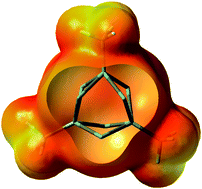Functionalized deltahedral Zintl complexes Ge9R3 (R = CF3, CN, and NO2): a new class of superhalogens†
Abstract
The assembly of atoms leads to the formation of clusters. These clusters have a tendency to gain their stability by forming either cations or anions. Among the anionic clusters, Zintl ions with multiple negative charges are a special type of inorganic complex generally formed from group 13, 14 and 15 elements in the periodic table. On the other hand, superhalogens are neutral molecules which have high electron affinity. Between the two different types of molecules, the former stabilized in the neutral state by forming a phase with alkali metal atoms, while the latter prefers the anionic state. Using first principle calculations, we show that it is also possible to design superhalogens having a Zintl core by functionalizing with suitable ligands like CF3, CN and NO2. The vertical detachment energies of these complexes indicate that they can be classified as superhalogens. The stability of these complexes is explained in terms of the jellium model. Density of states, partial density of states and natural localized molecular orbitals (NLMO) of these molecules lend additional information on the structure and bonding of these complexes.



 Please wait while we load your content...
Please wait while we load your content...